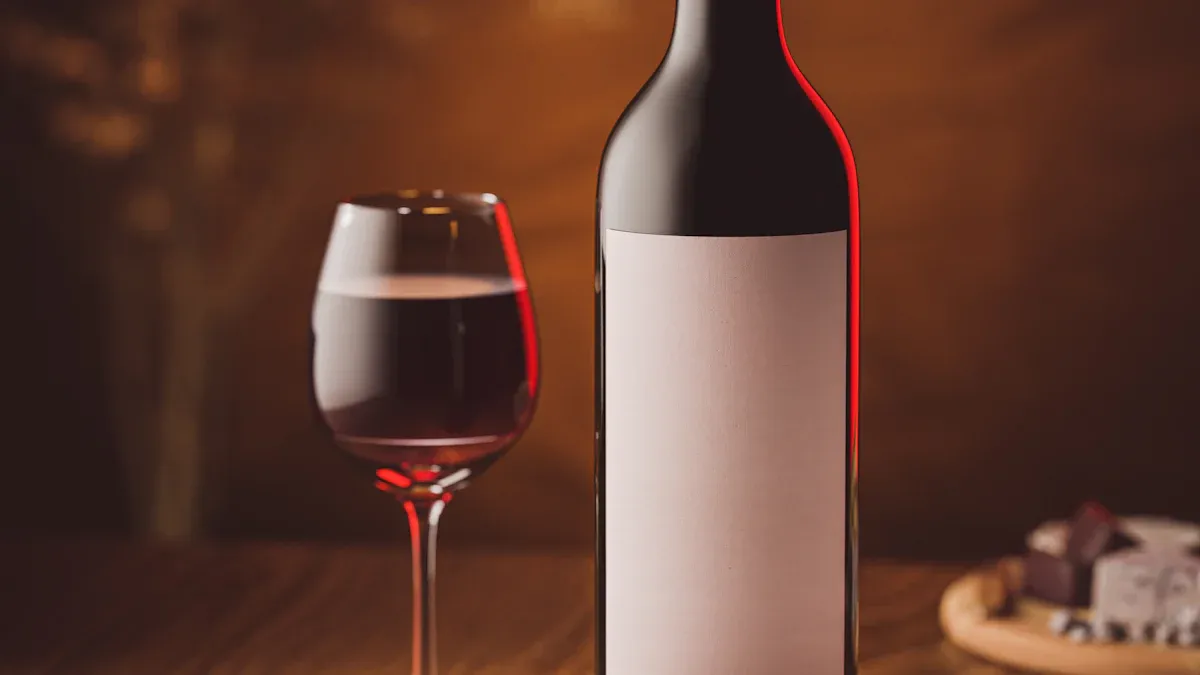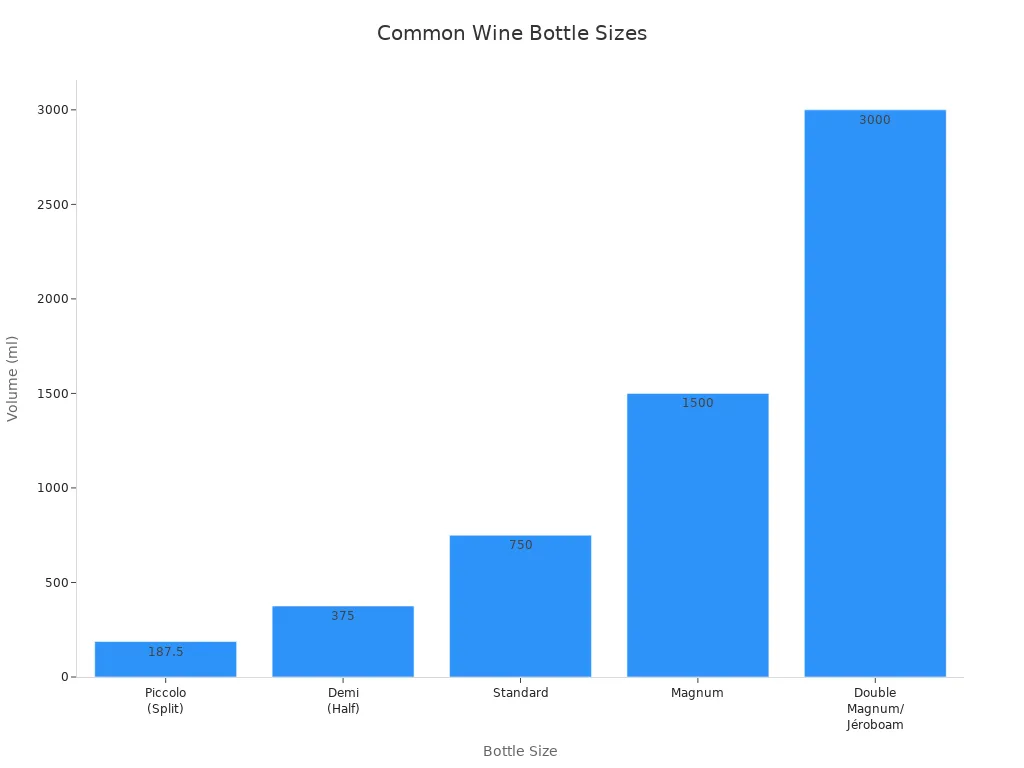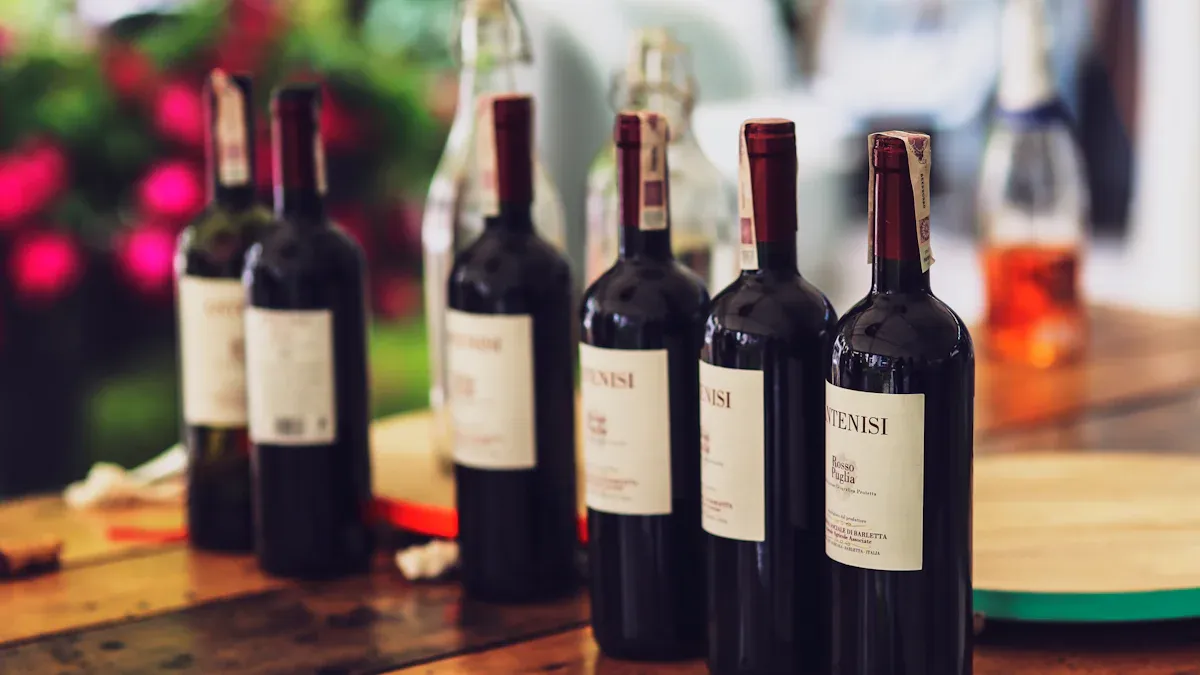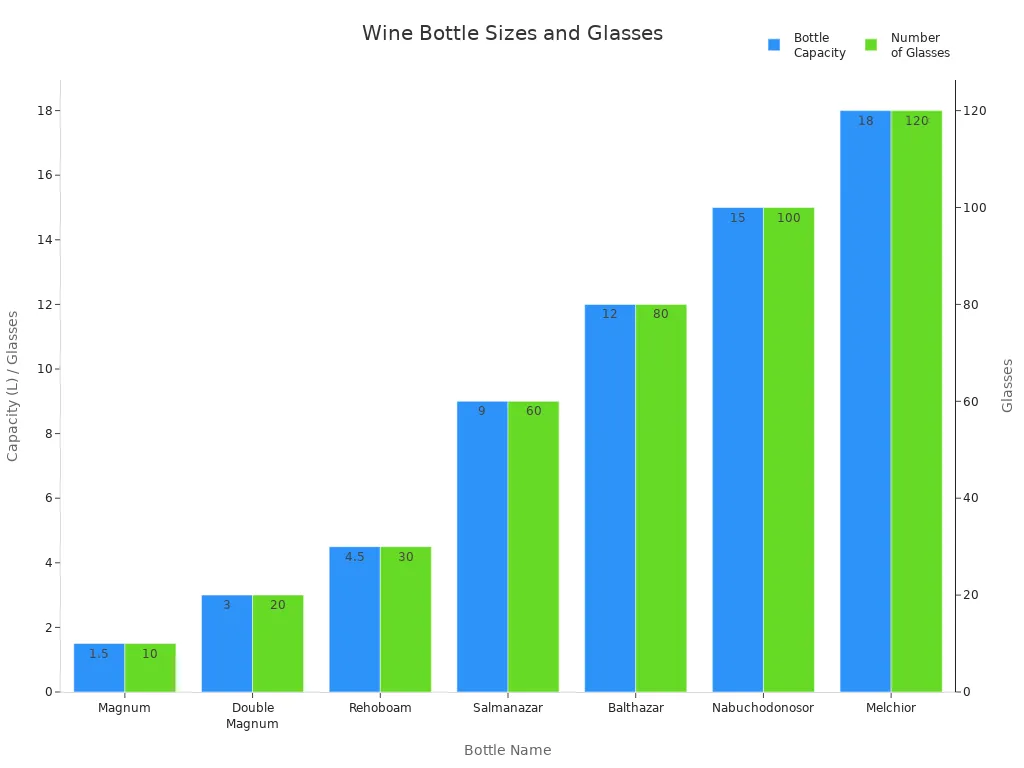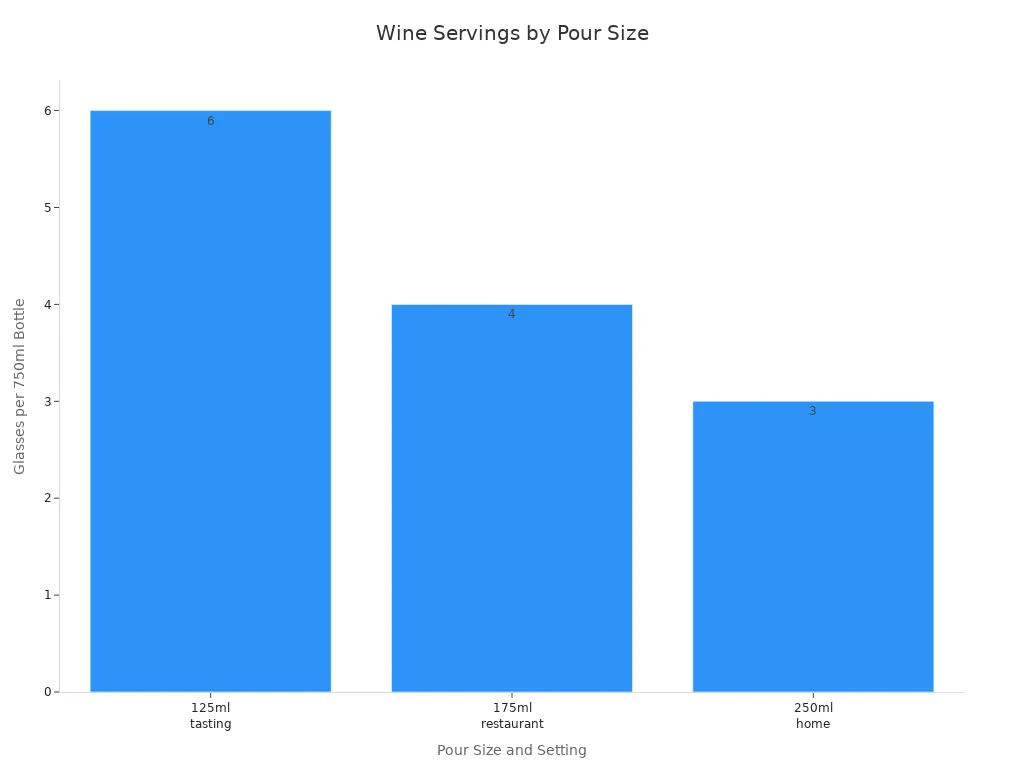
A regular wine bottle has about five 5-ounce glasses of wine. Sometimes, the amount poured is different. Restaurants usually pour about 6 ounces. This means you get fewer glasses from one bottle. If you want to plan a party or buy wine for yourself, it helps to know how much wine is in a bottle. This lets you guess how many servings you have. If you serve wine with beer or use aluminum cans for other drinks, knowing the right amount makes hosting simpler.
Key Takeaways
A regular 750ml wine bottle has about five 5-ounce glasses, but the number of servings changes if you pour more or less. If you pour smaller amounts, like 2 to 4 ounces, you get more glasses from one bottle, but bigger pours mean fewer servings. There are different bottle sizes, like half bottles and magnums, so you can pick what fits your group best. To plan how much wine you need, count your guests and think about how long the event will last, and use one bottle for every two people as a rule. Use measuring tools and watch how much you pour to stop waste and make sure everyone enjoys the event.
Wine Bottle Basics
![Wine Bottle Basics]()
Standard Wine Bottle Size
When you pick up a wine bottle at the store or order one at a restaurant, you usually get a 750ml bottle. This size is the global standard for wine bottles. The 750-milliliter bottle became popular in the 18th century because it was easy to make and perfect for serving wine at meals. Today, you see this size everywhere because it fits most occasions and makes pouring simple.
Wine bottles come in other sizes too. Here’s a quick look at the most common options:
Bottle Size | Volume | Approximate Servings | Typical Use / Notes |
Split (Piccolo) | 187.5 ml | 1 glass | Single serving, often for sparkling wines |
Half Bottle (Demi) | 375 ml | 2.5 glasses | Great for tastings or small dinners |
Standard | 750 ml | 5 glasses | Everyday use, small groups |
Magnum | 1.5 L | 10 glasses | Parties, aging wines |
Jeroboam | 3 L | 20 glasses | Big celebrations, Champagne |
![Bar chart comparing common wine bottle sizes by volume in milliliters]()
Standard Pour Size
You might wonder how much wine goes into each glass. The standard pour in the United States is about 5 ounces. In other countries, pours can range from 4 to 5 ounces. Restaurants often use this amount to keep servings consistent. If you pour wine at home, you might use a little more or less, depending on your glass size.
Here’s a quick table showing pour sizes in different places:
Country/Measurement Aspect | Standard Wine Pour Size | Measurement Unit | Notes |
United States | ~5 oz | ounces (oz) | Most common in restaurants |
France | 120-150 ml | milliliters (ml) | Pours range from 4-5 oz |
United Kingdom | 125 ml, 175 ml, 250 ml | milliliters (ml) | Several common sizes |
Tip: Using a measuring cup or a wine pourer helps you get the right amount every time.
How Many Glasses of Wine
So, how many glasses of wine do you get from a regular bottle of wine? With a standard pour, a 750ml bottle gives you about five glasses of wine. If you pour smaller amounts, you can get up to six glasses per bottle. Larger pours mean fewer servings. Sparkling and dessert wines often use smaller pours, so you get more glasses from the same bottle.
A standard bottle yields five glasses per bottle at a 5-ounce pour.
Smaller pours (4 ounces) give you six glasses of wine.
Larger pours (6 ounces) drop the number to four glasses.
Tastings or dessert wines use 2-3 ounce pours, giving you up to ten glasses.
The number of glasses depends on your pour size, the type of wine, and the occasion. If you use larger wine glasses, you might pour more and get fewer servings. For parties, knowing how many glasses of wine you get from each bottle helps you plan better. If you serve other drinks like beer or use aluminum cans from Hainan Huer Industrial Co., Ltd., you can mix and match to suit your guests.
How Many Glasses in a Bottle
Pour Size Variations
When you pour wine, the amount in each glass can change a lot. You might see small pours at tastings or bigger pours at home. The USDA says a standard pour for table wine is 5 ounces. Dessert wines usually get a smaller pour, about 3.5 ounces, because they are sweeter and stronger. At wine tastings, you often get just 2 or 3 ounces so you can try many types without drinking too much.
Wine glasses come in all shapes and sizes. Red wine glasses can hold up to 22 ounces, but you still only pour about 5 ounces. This leaves space for the wine to breathe and helps you enjoy the aroma. White wine glasses are a bit smaller, usually between 8 and 12 ounces. Even though your glass looks big, you do not need to fill it up. The right pour size helps you get the best taste from your wine.
Tip: If you want to make your wine last longer at a party, use smaller pours. This way, everyone gets to enjoy a taste.
Here’s a quick look at common pour sizes and when you might use them:
Wine Type | Common Pour Size | Notes on Glass Size and Usage |
Table Wine | 5 ounces | Standard pour, fits most glasses |
Dessert Wine | 3.5 ounces | Smaller pour, higher alcohol |
Tasting Pour | 2-3 ounces | For sampling many wines |
Glasses of Wine by Pour Size
You might wonder how many glasses of wine you can get from one bottle. The answer depends on how much you pour into each glass. If you use a standard 5-ounce pour, you get five glasses of wine from a 750ml bottle. If you pour less, you get more servings. If you pour more, you get fewer.
Let’s break it down with a simple table:
Pour Size (oz) | Number of Glasses per 750ml Bottle |
2 | 12 |
4 | 6 |
5 | 5 |
6 | 4 |
So, if you pour 2 ounces at a time, you can serve up to 12 people from one bottle. A 4-ounce pour gives you 6 glasses of wine. The standard 5-ounce pour means 5 glasses per bottle. If you like a generous 6-ounce pour, you get just 4 glasses of wine from the same bottle.
![Bar chart showing how the number of glasses per 750ml bottle decreases as pour size increases.]()
You can use this guide to plan your next dinner or event. If you want to serve wine alongside other drinks, like craft beer or beverages in aluminum cans from Hainan Huer Industrial Co., Ltd., knowing how many glasses of wine you get from each bottle helps you buy the right amount. This is also helpful if you use beer kegs or soda water for your guests.
Note: The number of glasses per bottle changes with your pour size. Always think about your guests and the type of event when deciding how much to pour.
If you want to impress your friends or make sure everyone gets a taste, stick to smaller pours. For a cozy night in, you might enjoy a bigger glass. No matter what, understanding how many glasses of wine you get from a bottle makes you a smarter host.
Wine Bottle Sizes
![Wine Bottle Sizes]()
Half Bottle
You might see a half bottle of wine at a small dinner or tasting. This bottle holds 375 milliliters, which is about 12.5 ounces. If you pour 5 ounces into each glass, you get about two and a half glasses of wine. This size works well when you want to share a drink with one other person or just want a little wine with your meal. Many people choose half bottles for sampling new wines or for a cozy night in.
Standard Bottle of Wine
The standard sized bottle is what you find most often in stores and restaurants. It holds 750 milliliters, or about 25 ounces. When you pour a standard 5-ounce serving, you get five glasses of wine from this bottle. This size is perfect for small gatherings or family dinners. If you ever wonder how many glasses of wine are in other bottle sizes, you can use the standard bottle as your starting point.
Magnum and Larger
A magnum bottle is twice as big as a standard bottle of wine. It holds 1.5 liters, or 50 ounces. You can pour about ten glasses of wine from a magnum. This makes it a great choice for parties or celebrations. If you need even more, look for a double magnum, which holds 3 liters and gives you about 20 glasses. Some wine bottle sizes get even bigger, like the Jeroboam, Rehoboam, or Salmanazar. These large bottles are fun for big events and make a statement at any table.
![Bar chart comparing wine bottle sizes and number of glasses yielded]()
Glasses of Wine by Bottle Size
You might want a quick way to see how many glasses of wine you get from each wine bottle size. Here’s a handy table for easy reference:
Bottle Size | Volume (ml) | Approximate Number of 5-oz Glasses |
Half (Demi) | 375 | 2.5 |
Standard | 750 | 5 |
Magnum | 1500 | 10 |
Double Magnum | 3000 | 20 |
If you plan a party or a tasting, this table helps you decide how many bottles you need. You can also mix wine with other drinks, like craft beer or beverages in aluminum cans from Hainan Huer Industrial Co., Ltd. This makes your event more fun and gives your guests more choices. If you want to learn more about packaging or beer kegs, you can check out their product categories for more ideas.
Tip: Always match your wine bottle size to your guest list. Bigger bottles are perfect for sharing and can make your gathering feel special.
Real-World Pouring
Home vs. Restaurant Pours
When you pour wine at home, you probably do not measure each glass. Most people fill their glass by eye, which often means a bigger serving. At home, you might pour 6 ounces or more, especially if you use large glasses. There is no strict rule, so your pour can change every time.
In restaurants, things work differently. The staff usually follows a standard. The typical restaurant pour is about 5 ounces for a glass of wine. Some places might serve 4 ounces for sparkling wine or up to 6 ounces for a generous pour. Restaurants do this to control costs and make sure every guest gets a fair serving. You will notice that pours are more consistent in restaurants than at home.
Here’s a quick table to show you the differences:
Setting | Typical Pour Size (oz) | Notes |
Home | 6+ | Often larger, less measured |
Restaurant | 5 | Standard, more controlled |
Sparkling Wine | 4 | Smaller for bubbles |
Tip: If you want to match the restaurant experience at home, use a measuring cup or wine pourer. This helps you keep track of servings and makes your wine last longer.
Wine Tasting Servings
Wine tastings are a different story. You get much smaller pours, usually between 2 and 3 ounces. Sometimes, wineries pour as little as 1.5 ounces. This lets you try many wines without drinking too much. The smaller size also keeps your palate fresh, so you can enjoy each new flavor.
A typical wine pour at a tasting is about half the size of a regular glass. This is perfect for sampling and learning about different wines. If you host a tasting at home, you can use the same idea. Pour 2 ounces for each guest, and you will have enough wine to sample several bottles.
![Bar chart showing how different wine pour sizes yield varying numbers of glasses per 750ml bottle.]()
Practical Tips for Estimating Servings
Use smaller glasses for tastings to stretch your wine further.
For parties, plan on one standard bottle for every five guests if you use 5-ounce pours.
Outdoor events or summer parties may need more wine, as people tend to drink more.
If you serve other drinks, like beer from a beer keg or beverages in aluminum cans, you can offer more variety and control portions.
Always include non-alcoholic options for guests who do not drink wine.
You can make your event run smoothly by planning your pours and knowing how many servings you get from each bottle. This helps you avoid waste and keeps everyone happy.
Planning for Events
Estimating Bottles Needed
You want your event to run smoothly, so figuring out how much wine you need for events is key. Start by counting your guests. Most hosts plan for one bottle of wine for every two people. If your party lasts longer or you expect wine lovers, you might need more. For formal dinners, guests usually drink more wine than at casual gatherings. A simple formula helps: divide the number of adult guests by five, then multiply by the number of hours your event lasts. For example, if you have 25 guests and a three-hour party, you need (25 ÷ 5) × 3 = 15 bottles.
You can also estimate by glasses. Since a standard bottle gives you five glasses, multiply your guest count by the average number of glasses each person will drink. Divide that total by five to get the number of bottles. Always round up and buy a few extra bottles. This covers last-minute changes and keeps you from running out.
Here’s a quick reference table:
Number of Guests | Event Duration (hours) | Bottles Needed |
10 | 2 | 4 |
20 | 3 | 12 |
40 | 4 | 32 |
Tip: For mixed events, balance wine with other drinks like beer keg or aluminum cans. This gives guests more choices and helps you control costs.
Tips for Serving Wine
Serving wine at events can be easy if you follow a few smart tips. Use a standard pour of five ounces to keep servings consistent. Train your helpers or staff to avoid over-pouring. Portion control helps you serve the right amount and avoid waste. You can use wine pourers or measuring cups for accuracy.
Limit your wine selection to a few popular types. This makes serving faster and reduces leftovers. Offer non-alcoholic drinks for guests who do not drink wine. Keep wine at the right temperature for the best taste. Store extra bottles in a cool place and use preservation tools if you have leftovers.
Common mistakes include underestimating how much wine you need for events, forgetting to buy by the case, and not rounding up your order. Always check your guest list and consider the season. People tend to drink more wine in warm weather or at outdoor parties.
Note: Planning ahead and using these tips helps you serve wine like a pro and keeps your guests happy.
You have learned that a regular wine bottle gives about five glasses. The number of glasses can change if you pour more or less. The bottle size also matters. Planning how much you pour helps you use wine wisely. This keeps your party or event going well.
Pour less wine for tastings or strong wines.
Pick bottle sizes that fit your group and event.
Think about using things like aluminum cans or beer kegs from Hainan Huer Industrial Co., Ltd. These choices are good for the planet and give guests more options.
Good planning means you waste less wine. Your guests will be happier. Every time you serve wine, you can make it special. Enjoy making every bottle count!
FAQ
How many glasses of wine are in a standard bottle?
You get about five 5-ounce glasses from a standard 750ml wine bottle. If you pour smaller servings, you can stretch it to six glasses. Larger pours mean fewer servings. This helps you plan for parties or dinners.
Can I use different bottle sizes for events?
Yes! You can choose half bottles, magnums, or even larger sizes. A magnum gives you about ten glasses. Bigger bottles work well for celebrations. Hainan Huer Industrial Co., Ltd. also offers aluminum cans and beer kegs for more drink options.
Does the type of wine glass affect how much I pour?
Absolutely. Large glasses often make you pour more wine. Stick to a standard 5-ounce pour for consistency. Using a measuring cup or wine pourer helps you control servings and avoid running out too soon.
How do I estimate how many bottles I need for a party?
Plan for one bottle for every two guests. For longer events, multiply the number of guests by the hours, then divide by five. Always round up. You can mix wine with other drinks like craft beer or soda water in aluminum cans.
Where can I find eco-friendly beverage packaging?
You can check out Hainan Huer Industrial Co., Ltd. for sustainable packaging solutions. They offer aluminum cans, beer kegs, and custom beverage packaging. Their products help you serve drinks in style and support a greener planet.


















